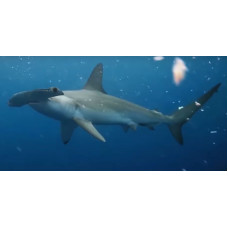Latin name
Sphyrna zygaena
Other name
Sphyrna zygaena
Identification
It differs from other large hammerheads in the shape of its head - its leading edge is curved and there is no depression in the middle. "The hammer is comparatively broad but short, 26-29% of the body length in cross section. The nostrils are located almost at the ends of the head projections, with long grooves leading to the center of the head. The mouth has 26-32 rows of teeth on the upper jaw and 25-30 on the lower jaw. Each tooth is triangular with smooth or slightly serrated edges. The body is spindle-shaped, with no ridge between the dorsal fins. The placoid scales are densely arranged, each bearing 5-7 horizontal ridges (3 in immature individuals) leading to a W-shaped posterior margin.
Features of fish fins
The first dorsal fin is moderately high and crescent-shaped with a rounded tip. Caudal margins of pectoral and ventral fins nearly straight. Anal fin larger than second dorsal fin, with long free posterior tip and strong notch on caudal margin.
Fish colouring
Coloration is dark brown or olive in contrast to the solid brown of most other hammerheads, lighter on the sides, belly white, and sometimes the pectoral fins have a dark ventral border.
Distribution
The most temperate species, occurring worldwide at higher latitudes than any other Sphyrna species. In the Atlantic Ocean, it is found from Nova Scotia to the Virgin Islands, from Brazil to southern Argentina in the west, from the British Isles to the Ivory Coast, including the Mediterranean, in the east. Occasionally enters the Black Sea. In the Indian Ocean, it inhabits the coasts of South Africa, India, and Sri Lanka. In the western Pacific, it is common from Buckbo Bay (Tonkin Bay) to southern Japan and Siberia, and off the coast of Australia and New Zealand. In the central and eastern Pacific, it is found off Hawaii and the Galapagos Islands, the coasts of California, Panama, Ecuador, and Chile.
Habitat
They stay closer to the surface, at depths of less than 20 m. However, there is evidence that this species can dive to depths of up to 200m. They prefer coastal waters, bays and estuaries, but are sometimes found in the open ocean, on the continental shelf and around oceanic islands. There is evidence of this shark in freshwater (e.g. Indian River in Florida).
Size
The second largest hammerhead after the giant hammerhead, averaging 2.5-3.5 m in length. The maximum recorded length and mass are 5 m and 400 kg respectively.
Behavior
Smooth hammerheads migrate to the poles in the summer to stay in cooler water and return to the equator in the winter. Adult sharks are solitary or form small schools. They can gather in large numbers during the annual migration. In the heat of summer, these sharks can be seen at the surface with their dorsal fins protruding from the water.
Food and feeding habits
They are active predators that feed on bony fish, rays, sharks (including their own species), cephalopods and, to a lesser extent, crustaceans such as shrimp and crabs. They eat prey easily off the hook. In some areas, stingrays are the favorite prey of common hammerheads and make up a large portion of their diet. Sharks often have fragments of poisonous spines in their mouths. In Northern Europe they feed on herring and sea bass, and in North America on Spanish mackerel and menhaden. Off the coast of South Africa, they prey on common squid and small gregarious fish such as sardines. In Australia, squid form the basis of their diet, followed by bony fish.
Reproduction
There are 20-40 cubs in a litter. Pregnancy lasts 10-11 months. Births occur in small natural coastal nurseries such as Bulls Bay in North Carolina. Newborns are 50-61 centimeters in length. Females reach sexual maturity at 2.7 m and males at 2.1-2.5 m, depending on habitat. Off the coast of South Africa, pregnant females are caught in February and females with full-term embryos in November; off the east coast of Australia, births occur between January and March, with ovulation occurring around the same time. These sharks are thought to live for 20 years or more.
Fishing
Fished commercially throughout the world, including the United States (east and west coasts), Brazil, Spain, Taiwan, the Philippines, southwestern Australia, and West Africa, primarily using gillnets and longlines.
Relationship with a person
Potentially dangerous to humans. The fins of these sharks are highly prized. There have been reports of meat poisoning. Used in Chinese medicine.
| Classification | |
| Phylum | Chordata |
| Class | Chondrichthyes |
| Squad | Carcharhiniformes |
| Family | Sphyrnidae |
| Genus | Sphyrna |
| Species | S. zygaena |
| Features | |
| Conservation status | Vulnerable |
| Habitat | Pelagic |
| Life span, years | 20 |
| Maximum body weight, kg | 400 |
| Maximum length, cm | 500 |
| Sailing speed, m/s | No information |
| Threat to people | Edible |
| Way of eating | Predator |
Smooth hammerhead
Tags: smooth hammerhead



